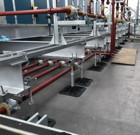Pump House at Wales hospital

University Hospital of Wales is a major 1000-bed hospital in the Heath district of Cardiff. UHW is a teaching hospital of Cardiff University School of Medicine. Kier Construction, the main contractor on the project, appointed Whitehead Building Services to oversee the installation of new rooftop air-handling units.
Flexi Support Systems were ordered, via BSS Cardiff, to support these rooftop services. However, due to the existing roof having load management limitations, the support framework for the largest and heaviest of the two air-handling units, had to be supported in a way that the load dispersal was concentrated directly above the main roof beams.
To achieve this, Pump House supplied their flexi heavy – flexi TWIN frame solutions, specifically designed to work with this type of restriction. Supplied with secondary support beams, the framework feet could then be positioned immediately above the main roof beams below. Pump House also factored in the correct amount of secondary support beams, to ensure all air-handling unit sections were adequately supported individually.
With the second air-handling unit being somewhat smaller and lighter in size, Pump House supplied their standard flexi-heavy - flexi Modular frame to support this unit, albeit at a higher than usual framework target height.








